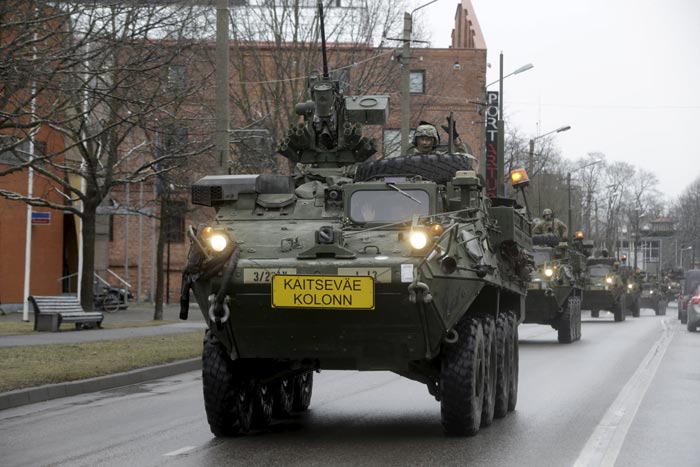Soldiers of the US Army 2nd Cavalry Regiment, deployed in Estonia as part of the US military's Operation Atlantic Resolve, arrive during the "Dragoon Ride" exercise in Parnu on Saturday. Operation Atlantic Resolve is aimed at demonstrating commitment to Nato allies in light of Russia's aggression in Ukraine, according to the US Army.
AFP/Donetsk
Artillery fire rocked the outskirts of the rebel-held east Ukraine city of Donetsk on Sunday in the latest clashes to rattle an internationally brokered ceasefire between pro-Russian separatists and Kiev.
The sound of intensive explosions began at 9.00 am (local time) and appeared to come from the area around Donetsk airport, one of several key flashpoints where shelling has rumbled on despite the February truce deal damping down fighting around much of eastern Ukraine.
The Ukranian army said rebels located near the airport had used small arms, 82mm mortars and rocket-propelled grenades against government troops overnight Saturday, but it did not announce any casualties.
In the separatist stronghold of Lugansk, the army also came under fire from small arms and heavier 120mm mortars, according to an official statement.
The overall rate of fighting has declined sharply in the weeks since the peace deal hammered out by the leaders of France, Germany, Russia and Ukraine, which obliges both sides to stop shooting and withdraw heavy weapons.
However, sporadic clashes with small arms and mortars has continued on a near daily basis at hotspots including the airport and around the key port of Mariupol.
According to the army, militants fired 120mm mortar shells at the village of Shyrokyne, a village around 20 kilometres east of Mariupol, overnight Saturday.
Many fear that the steel-making hub - the largest major city held by the government in the conflict zone - could become the focus of a new offensive, opening up a corridor between rebel-held territory and Russian-annexed Crimea.
Under the terms of the ceasefire, the two sides agreed to pull back their heavy arms to create a buffer zone of between 50km and 140km, depending on the range of the weaponry.
The warring parties both claim that they have withdrawn their big guns but the Ukrainian military on Friday accused separatists near Shyrokyne of using the heavy Grad multiple rocket system for "the first time in a month".
Weapons withdrawal
The supposed drawback is being monitored by the OSCE, but the international observer mission on Thursday said it had been unable to verify a credible withdrawal "because of a lack of cooperation on both sides."
Moscow on Saturday claimed that Kiev might be "bluffing" over it weapons withdrawal.
Ukraine President Petro Poroshenko, however, insisted late Saturday that Kiev was adhering to the peace deal.
"Ukraine strictly and consistently implements these steps," he told Ukraine channel Inter TV.
"Firstly, we ceased fire, secondly, we withdrew heavy equipment and artillery, thirdly, we ensured active work of OSCE monitors, who are able to check the implementation of these agreements".
However, the president warned he would respond with force in the event of a new large-scale attack.
"We are not daydreamers and we are doing everything so that if, God forbid, there is an offensive against Ukraine, we can repel the enemy with all our force and defeat it," the president said.

